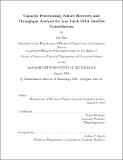| dc.contributor.advisor | Eytan Modiano. | en_US |
| dc.contributor.author | Sun, Jun, 1975- | en_US |
| dc.contributor.other | Massachusetts Institute of Technology. Dept. of Electrical Engineering and Computer Science. | en_US |
| dc.date.accessioned | 2005-05-19T15:11:05Z | |
| dc.date.available | 2005-05-19T15:11:05Z | |
| dc.date.copyright | 2002 | en_US |
| dc.date.issued | 2002 | en_US |
| dc.identifier.uri | http://hdl.handle.net/1721.1/16892 | |
| dc.description | Thesis (S.M.)--Massachusetts Institute of Technology, Dept. of Electrical Engineering and Computer Science, 2002. | en_US |
| dc.description | Includes bibliographical references (p. 85-87). | en_US |
| dc.description | This electronic version was submitted by the student author. The certified thesis is available in the Institute Archives and Special Collections. | en_US |
| dc.description.abstract | We investigate the capacity needed to build a restorable satellite network and design routing schemes to achieve high throughput. Specifically, the first part of this thesis considers the link capacity requirement for a LEO satellite constellation. We model the constellation as an N x N mesh-torus topology under a uniform all-to-all traffic model. Both primary capacity and spare capacity for recovering from a link or node failure are examined. In both cases, we use a method of \cuts on a graph" to obtain lower bounds on capacity requirements and subsequently find algorithms for routing and failure recovery that meet these bounds. Finally, we quantify the benefits of path based restoration over that of link based restoration; specifically, we find that the spare capacity requirement for a link based restoration scheme is nearly N times that for a path based scheme. In the second part of this thesis, we consider a packet switching satellite network in which each node independently generates packets with a fixed probability during each time slot. With a limited number of transmitters and buffer space onboard each satellite, contention for transmission inevitably occurs as multiple packets arrived at a node. We consider three routing schemes in resolving these contentions: Shortest Hops Win, Random Packet Win and Oldest Packet Win; and evaluate their performance in terms of throughput. Under no buffer case, the throughput of the three schemes are significantly different. However, there is no appreciable difference in the throughput when buffer is available at each node. Also, a small buffer size at each node can achieve the same throughput performance as that of infinite buffer size. Simulations suggests that our theoretical throughput analysis is very accurate. | en_US |
| dc.description.statementofresponsibility | by Jun Sun. | en_US |
| dc.format.extent | 87 p. | en_US |
| dc.format.extent | 633078 bytes | |
| dc.format.extent | 632721 bytes | |
| dc.format.mimetype | application/pdf | |
| dc.format.mimetype | application/pdf | |
| dc.language.iso | eng | en_US |
| dc.publisher | Massachusetts Institute of Technology | en_US |
| dc.rights | M.I.T. theses are protected by copyright. They may be viewed from this source for any purpose, but reproduction or distribution in any format is prohibited without written permission. See provided URL for inquiries about permission. | en_US |
| dc.rights.uri | http://dspace.mit.edu/handle/1721.1/7582 | |
| dc.subject | Electrical Engineering and Computer Science. | en_US |
| dc.title | Capacity provisioning, failure recovery and throughput analysis for low earth orbit satellite constellations | en_US |
| dc.type | Thesis | en_US |
| dc.description.degree | S.M. | en_US |
| dc.contributor.department | Massachusetts Institute of Technology. Department of Electrical Engineering and Computer Science | |
| dc.identifier.oclc | 51979253 | en_US |
